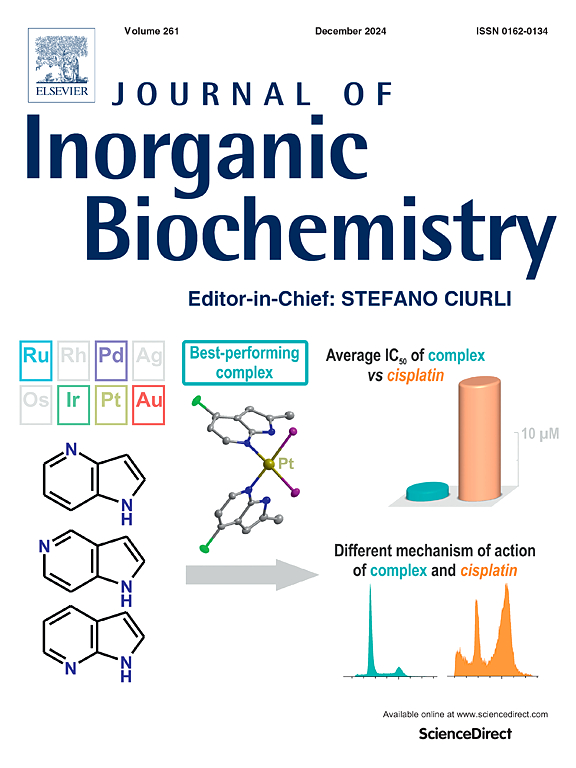Influence of the second coordination sphere on O2 activation by a nonheme iron(II) thiolate complex
IF 3.8
2区 化学
Q2 BIOCHEMISTRY & MOLECULAR BIOLOGY
引用次数: 0
Abstract
The synthesis and characterization of a new ligand, 1-(bis(pyridin-2-ylmethyl) amino)-2-methylpropane-2-thiolate (BPAMe2S−) and its nonheme iron complex, FeII(BPAMe2S)Br (1), is reported. Reaction of 1 with O2 at −20 °C generates a high-spin iron(III)-hydroxide complex, [FeIII(OH)(BPAMe2S)(Br)] (2), that was characterized by UV–vis, 57Fe Mössbauer, and electron paramagnetic resonance (EPR) spectroscopies, and electrospray ionization mass spectrometry (ESI-MS). Density functional theory (DFT) calculations were employed to support the spectroscopic assignments. In a previous report (J. Am. Chem. Soc. 2024, 146, 7915–7921), the related iron(II) complex, FeII(BNPAMe2S)Br (BNPAMe2S− = (bis((6-(neopentylamino)pyridinyl) methyl)amino)-2-methylpropane-2-thiolate) was reported and shown to react with O2 at low temperature to give a rare iron(III)-superoxide intermediate, which then converts to an S‑oxygenated sulfinate as seen for the nonheme iron thiol dioxygenases. This complex includes two hydrogen bonding neopentylamino groups in the second coordination sphere. Complex 1 does not include these H-bonding groups, and its reactivity with O2 does not yield a stabilized Fe/O2 intermediate or S‑oxygenated products, although the data suggest an inner-sphere mechanism and formation of an iron‑oxygen species that is capable of abstracting hydrogen atoms from solvent or weak C![]() H bond substrates. This study indicates that the H-bond donors are critical for stabilizing the FeIII(O2-•) intermediate with the BNPAMe2S− ligand, which in turn leads to S‑oxygenation, as opposed to H-atom abstraction, following O2 activation by the nonheme iron center.
H bond substrates. This study indicates that the H-bond donors are critical for stabilizing the FeIII(O2-•) intermediate with the BNPAMe2S− ligand, which in turn leads to S‑oxygenation, as opposed to H-atom abstraction, following O2 activation by the nonheme iron center.

第二配位球对非血红素铁(II)硫酸盐配合物O2活化的影响。
报道了新配体1-(双(吡啶-2-甲基)氨基)-2-甲基丙烷-2-硫代酸酯(BPAMe2S-)及其非血红素铁配合物FeII(BPAMe2S)Br(1)的合成和表征。1与O2在-20℃下反应生成高自旋铁(III)-氢氧化物配合物[FeIII(OH)(BPAMe2S)(Br)](2),通过UV-vis、57Fe Mössbauer、电子顺磁共振(EPR)谱和电喷雾质谱(ESI-MS)对其进行了表征。采用密度泛函理论(DFT)计算支持光谱分配。在之前的一份报告中(j.a m。化学。与之相关的铁(II)配合物FeII(BNPAMe2S)Br (BNPAMe2S- = (bis((6-(neopentylamino)pyridinyl) methyl)amino)-2-methylpropane-2-thiolate)在低温下与O2反应生成稀有的铁(III)-超氧化物中间体,然后转化为S-氧合亚硫酸盐,如非血红素铁硫醇双加氧酶所见。该配合物在第二配位球中包含两个氢键新戊基氨基。配合物1不包括这些氢键基团,它与O2的反应性不会产生稳定的Fe/O2中间产物或S氧产物,尽管数据表明球内机制和铁氧物质的形成能够从溶剂或弱CH键底物中提取氢原子。该研究表明,氢键供体对于用BNPAMe2S-配体稳定FeIII(O2-•)中间体至关重要,这反过来导致非血红素铁中心O2活化后的S-氧合,而不是h原子的提取。
本文章由计算机程序翻译,如有差异,请以英文原文为准。
求助全文
约1分钟内获得全文
求助全文
来源期刊

Journal of Inorganic Biochemistry
生物-生化与分子生物学
CiteScore
7.00
自引率
10.30%
发文量
336
审稿时长
41 days
期刊介绍:
The Journal of Inorganic Biochemistry is an established international forum for research in all aspects of Biological Inorganic Chemistry. Original papers of a high scientific level are published in the form of Articles (full length papers), Short Communications, Focused Reviews and Bioinorganic Methods. Topics include: the chemistry, structure and function of metalloenzymes; the interaction of inorganic ions and molecules with proteins and nucleic acids; the synthesis and properties of coordination complexes of biological interest including both structural and functional model systems; the function of metal- containing systems in the regulation of gene expression; the role of metals in medicine; the application of spectroscopic methods to determine the structure of metallobiomolecules; the preparation and characterization of metal-based biomaterials; and related systems. The emphasis of the Journal is on the structure and mechanism of action of metallobiomolecules.
 求助内容:
求助内容: 应助结果提醒方式:
应助结果提醒方式:


